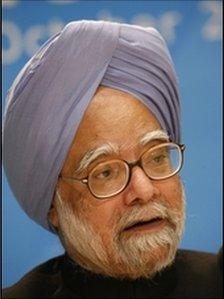Viewpoint: Global significance of India-China ties
- Published

Indian prime minister Manmohan Singh heads to China on Tuesday
Prime Minister Manmohan Singh's comment that India-China relations have transcended bilateral dimensions to acquire global strategic significance is indicative of the stakes in this high-profile meeting of the premiers of two of the world's largest nations.
The two countries together account for 36.7% of the world's population, 10.8% of its gross domestic product and 10.4% of the global trade.
Most importantly, these two are expected to lead the world out of its current economic slowdown.
India grew by 9.7% and China by 10.5% in 2010, while the rest of the world grew by barely 4%.
These significantly disparate growth rates between the rest of the world and these two are expected to persist in 2011 and possibly further into the future.
Different paths
The two countries together provide a diverse portfolio of growth drivers for the world economy as growth dynamics are very different in the two countries.
While China's growth is fuelled by public spending, India's is largely private investments-led.
While China's growth is dependent upon global markets, India's growth is largely domestic markets-driven.
India's growth prospects, therefore, are more sustainable than China's, but China's growth is faster than India's.
Trade between the two countries is very low. India accounts for 2% of China's foreign trade and China accounts for 9% of India's trade.
China's exports to India have increased dramatically in recent years, but India's exports have not.
India will look forward to increasing its exports to China.
China stands to gain from its export-oriented growth strategy and from India's growing domestic market.
In many industries, China and India compete in the international markets.
In this sense both have a stake in the sustained growth of the world economy.
Political roadblocks
It is unlikely that the two nations will achieve much if the discussions revolve around bilateral economic relations.
Significant gains are possible only if regional political equations improve.
China is perceived to be close to Pakistan, with whom India continues to find it difficult to bridge the confidence gap.
Discussions between India and Pakistan have too often ended up in public spats.
Public opinions in India and Pakistan have been soiled by events ranging from Kashmir and Kargil to cricket matches.
Happily, discussions with China are bereft of such nasty public displays, in spite of differences regarding the borders.
Bold steps by the leaders of the two nations to increase economic cooperation and to ease border tensions are likely to be acceptable more easily than similar initiatives that India may attempt with Pakistan.
The two countries can much more easily and effectively address the regional political problems.
And, the impact of this regional solution would be much larger than what the two may achieve on the larger global scene.
Lives of millions from Tibet and Kashmir through Arunachal Pradesh can be dramatically impacted if the two nations reduce or eliminate the impasse on the borders.
By resolving the regional political equations, India and China can more effectively transcend the bilateral dimensions Prime Minister Manmohan Singh alluded to.
The opinions expressed are those of the author and are not held by the BBC unless specifically stated. The material is for general information only and does not constitute investment, tax, legal or other form of advice. You should not rely on this information to make (or refrain from making) any decisions. Links to external sites are for information only and do not constitute endorsement. Always obtain independent, professional advice for your own particular situation.